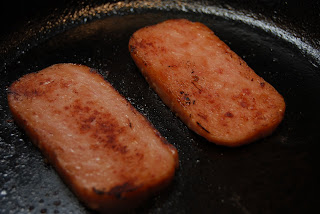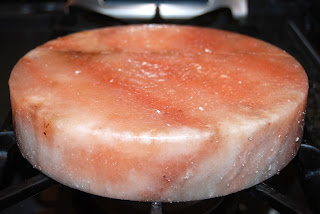The sous vide salmon was inspired by a friend of mine, Ian who told me about his experimentation with sous vide fish and the great results he had with salmon. I had some frozen cooper river salmon in my freezer so I decided to give it a shot. Here were the 3 dishes that I cooked tonight:
- Sous Vide Salmon Spinach Salad - Wife
- Sous Vide Salmon w/ Vegetarian Fried Rice - Step Daughter
- Almost Vegan Rice Noodles Tofu Stir-Fry - Me
I would also recommend using fresh salmon instead of previously frozen if you can find some in season. The next thing is to rinse the brine with clean water, dried with a paper towel, and lightly seasoned it with black peppers. I didn't season it with salt since brining will add salt in the salmon already. Add a couple of teaspoons of olive oil and then vacuum back the salmon.
I preheated the sous vide machine to 125 degrees and placed it in the water bath for about 20 minutes. The results was quite amazing! Generally after sous vide cooking the food is not always aesthetic pleasing but with salmon it's not too bad.
I then pan seared it with olive oil on high heat for about 30 seconds on each side to give it some color.
The salmon came out amazing! For my wife I placed it on a bed spinach with diced yellow bell peppers, and crumbled Boison herbed cheese. She thought the salmon was one of the best cooked salmon I ever cooked! Thanks Ian for the recipe :)
The vegetarian fried rice is an easy recipe. I used 1 egg beaten, leftover rice (leftover is better than freshly cooked rice), and chopped Asian vegetables (Yu Choy) that I had in the refrigerator. Any type of stalk/root vegetables like string beans, carrots, peas, or asparagus would work fine too. First thing is to cook the egg with a little oil and whip as much air into it to keep it light.
Remove the egg and set it aside. Add the vegetables next with oil and add some liquid to help steam the vegetables to cook it through. The most important thing is to not over cook!
Add the leftover rice into the wok and then add a little chicken broth. Continue to stir fry until the rice has heated through. Add the cooked egg back into the wok and season with salt as needed. I would generally add some green onion to provide a more aromatic taste. The end result is quite spectacular with or without the salmon.
Almost vegan rice noodles tofu stir-fry. Since I'm vegan today I decided to make this stir fry for myself. I took some wide rice noodles that I purchased at one of the Asian markets a couple of days ago and separate them in strips.
I then chopped whatever vegetables I had in the refrigerator - today's veggies happened to be Chinese broccoli, fresh shitake mushrooms, and green onions. The protein I used was fresh firm tofu. I would occasionally use fried tofu depending on what I had available.
I decided today to use two types of seasoning - a vegetarian bouillon base that is flavored with mushrooms and an XO sauce. The XO sauce is what makes it "almost" vegan because it contains minute amount of dried preserved scallops.
Heat up a wok to high heat until it begins to smoke. Add either peanut or olive oil to the wok until the oil smokes. Add the mushroom and the tofu and quickly stir-fry. The mushroom requires a liquid to fully cook so it is necessary to add some of the vegetarian bouillon until you have a nice glaze on the mushroom and tofu.
Remove and set aside. Head up the wok again and add a little oil and then the vegetables. Add liquid if necessary to cook the vegetable through and then add the rice noodles.
Add the remaining bouillon and the XO sauce and quickly stir fry until the rice noodles have cooked through. Add the mushroom, tofu, and green onion back into the wok and quickly stir fry everything.
After 2-3 minutes it is fully cooked and ready to be served on a plate :)
Enjoy!!


















































